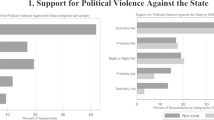Abstract
Chicago’s CeaseFire program is an evidence-based public health approach to preventing gun violence. Baltimore is one of many US cities attempting to replicate the program. We compared changes in the number of homicide and nonfatal shooting incidents per month in four intervention neighborhoods with changes in high-crime comparison areas (police posts) without the intervention, while controlling for several measures of police activity and baseline levels of homicide and nonfatal shootings. In South Baltimore there were large program-related reductions in homicide and nonfatal shooting incidents. Among three East Baltimore program sites, the program was associated with a reduction of homicides in one area, a reduction in nonfatal shootings in another area, and a simultaneous increase in homicides and decrease in nonfatal shootings in another area. In some instances, program effects extended to neighborhoods bordering the intervention areas. Program-related reductions in homicides appear to be linked with conflict mediations conducted by program outreach workers.





Similar content being viewed by others
References
National Center for injury Prevention and Control. Web-based Injury Statistics Query And Reporting System (WISQARS) fatal injury reports: leading causes of death reports. Atlanta: Centers for Disease Control and Prevention; April, 2009.
Centers for Disease Control and Prevention. Web-based Injury Statistics Query And Reporting System (WISQARS) injury mortality reports. Atlanta; Accessed July 20, 2011.
Centers for Disease Control and Prevention, National Center for Injury Prevention and Control. Web-based Injury Statistics Query and Reporting System (WISQARS)—non-fatal injuries. http://webappa.cdc.gov/sasweb/ncipc/nfirates2001.html. Accessed July 20, 2011.
Centers for Disease Control and Prevention, National Center for Health Statistics. Compressed Mortality File 1999–2007. CDC WONDER on-line database, compiled from compressed mortality file 1999–2007 Series 20 No. 2M, 2010. Accessed at http://wonder.cdc.gov/cmf-icd10.html on Oct 28, 2011.
Fowler PJ, Tompsett CJ, Braciszewski JM, Jacques-Tiura AJ, Baltes BB. Community violence: a meta-analysis on the effect of exposure and mental health outcomes of children and adolescents. Dev Psychopathol. 2009; 21: 227–259.
Roman CG, Knight CR, Chalfin A, Popkin SJ. The relation of the perceived environment to fear, physical activity, and health in public housing developments: evidence from Chicago. J Public Health Policy. 2009; 30(Suppl 1): S286–S308.
Anderson E. The code of the street: decency, violence, and the moral life of the inner city. New York: WW Norton & Co; 1999.
Wilkinson DL. Guns, violence, and identity among African American and Latino youth. New York: LFB Scholarly Publishing; 2003.
Rich JA, Stone DA. The experience of violent injury for young African American men: the meaning of being a sucker. J Gen Intern Med. 1996; 11(6): 77–82.
Koper CS, Mayo-Wison E. Police crackdowns on illegal gun carrying: a systematic review of their impact on gun crime. J Exp Criminol. 2006; 2: 227–261.
Braga AA, Kennedy DM, Waring EJ, Piehl AM. Problem-oriented policing, deterrence, and youth violence: an evaluation of Boston’s Operation Ceasefire. J Res Crime Delinq. 2001; 38: 195–225.
Corsaro N, McGarrell EF. Testing a promising homicide reduction strategy: reassessing the impact of the Indianapolis “pulling levers” intervention. J Exp Criminol. 2009; 5: 63–82.
Corsaro N, McGarrell EF. Reducing homicide risk in Indianapolis between 1997 and 2000. J Urban Health. 2010; 87: 851–864.
Papachristos A, Meares T, Fagan J. Attention felons: evaluating project safe neighborhoods in Chicago. J Empir Leg Stud. 2007; 4: 223–272.
Braga AA, McDevitt J, Pierce GL. Understanding and preventing gang violence: problem analysis and response development in Lowell, Massachusetts. Police Q. 2006; 9: 20–46.
Prothrow-Stith D, Spivak H. Murder is no accident: understanding and preventing youth violence in America. Josey-Bass; 2003.
Chicago Project for Violence Prevention, www.ceasefirechicago.org.
Skogan WG, Hartnett SM, Bump N, Dubois J. Evaluation of CeaseFire—Chicago. Evanston: Northwestern University; 2008.
Ransford C, Kane C, Slutkin G. CeaseFire Chicago: an analysis of the effects of a funding interruption on the CeaseFire intervention. Presented at the annual meeting of the American Public Health Association, Philadelphia, November 2009.
Wilson JM, Chermak S. Community-driven violence reduction programs: examining Pittsburgh’s One Vision One Life. Criminol Public Policy. 2011; 10: 993–1027.
Ferrier M, Ludwig J. Crime policy and informal social control. Criminol Public Policy. 2011; 10: 1029–1036.
Fagan J, Wilkinson DL, Davies G. “Social contagion of violence.” In: Waldman, eds. The Cambridge handbook of violent behavior. Cambridge: Cambridge University Press; 2007.
Cameron AC, Trivedi PK. Regression analysis of count data. Cambridge University Press; 1998.
Zeger SL, Liang K-Y. Longitudinal data analysis for discrete and continuous outcomes. Biometrics. 1986; 42: 121–130.
Tauchen H. Estimating the supply of crime: recent advances. In: Benson BL, Zimmerman PR, eds. Handbook on the economics of crime. Northhampton: Edward Elgar Publishing; 2010.
Anselin L. Local indicators of spatial association—LISA. Geogr Anal. 1995; 27(2): 93–115.
Fenton J, Calvert S. 18 shootings stem largely from drug feud, police say: two fatally shot, 16 wounded in shootings on day of mayhem on Baltimore’s east side. The Baltimore Sun; July 28, 2009.
Acknowledgments
Funding for this study was provided by a grant from the Centers for Disease Control and Prevention (CE000728) and a contract with the Baltimore City Health Department.
Author information
Authors and Affiliations
Corresponding author
Rights and permissions
About this article
Cite this article
Webster, D.W., Whitehill, J.M., Vernick, J.S. et al. Effects of Baltimore’s Safe Streets Program on Gun Violence: A Replication of Chicago’s CeaseFire Program. J Urban Health 90, 27–40 (2013). https://doi.org/10.1007/s11524-012-9731-5
Published:
Issue Date:
DOI: https://doi.org/10.1007/s11524-012-9731-5




